The origins of the Way of St James from Santiago to Fisterra and Muxía are closely linked to the legends created to Christianise the westernmost regions of Galicia, where ancient beliefs in nature spirits and fertility were very deeply rooted.
The connection between Fisterra and the worship of St James starts with the legend of the “Translatio”, the transfer of the mortal remains of St James the Apostle to Galicia, which was created in the Middle Ages and mentioned in the Codex Calixtinus. According to the legend, to be able to bury the remains of the saint in this area, the disciples of St James had to go to the city of Digium in the Duio valley (Fisterra) and ask for authorisation from the Roman governor.
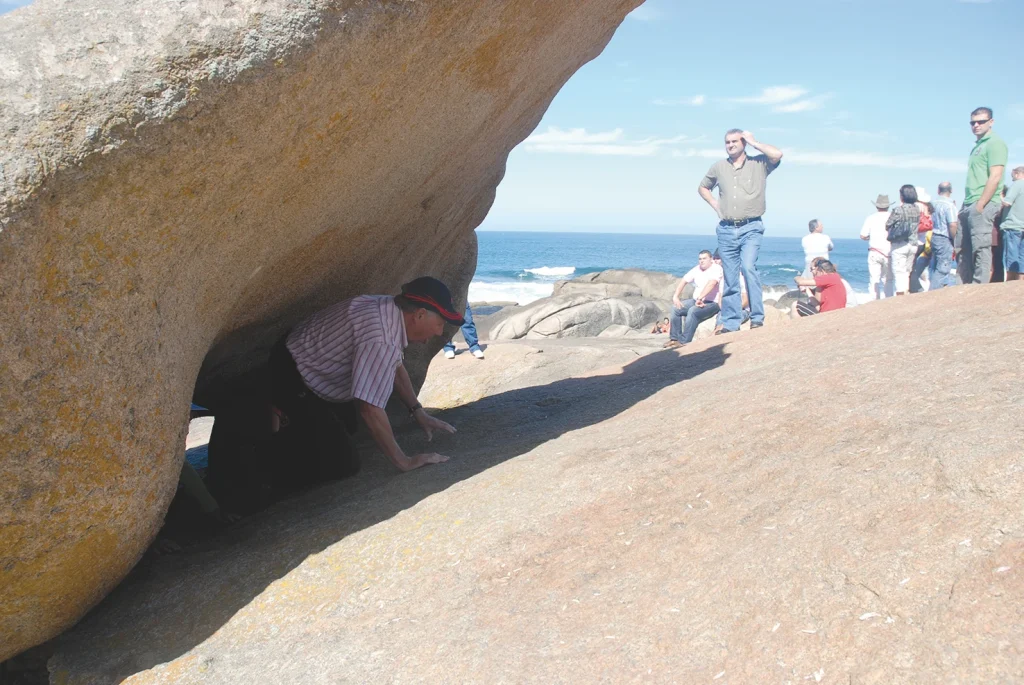
The inclusion of Muxía in the traditions is related to the stones of As Cruces or Punta de Xaviña and with the Virgen de A Barca, who appeared here before St James. The Virgin arrived on a stone boat sailed by angels. This legend was almost certainly created by the monks of the monastery of Moraime, which was a centre for evangelism in the region. Were the monks the inventors of the traditions of St James in Fisterra and Muxía?
The fact that the Catholic church chose such important divinities as Christ, the Virgin Mary and St James the Apostle and placed them in Fisterra is indicative of the difficulties that must have existed in converting the local population to Christianity. The two most important religious centres in the region were dedicated to the first two figures: the Christ of Fisterra and the Virgin of A Barca. According to local legends both images arrived from the sea, which would be the logical route in a region that was so badly connected by land to the rest of the continent.
After the legends and apparitions and the subsequent founding of these two important centres of faith, pilgrims began to arrive in the mid-12th c., testimonies of which can be seen in documents at the monastery of Moraime.
When the two centres had begun to acquire some degree of importance as centres of pilgrimage in the 15th., we see the first testimonies written by pilgrims and travellers. One of the first was the Frenchman Nompar II, lord of Caumont (1417), who arrived at Fisterra and mentioned the hermitage of San Guillerme. Some years later the German Sebastián Ilsung (1446) arrived at Muxía, where he appears in an image praying in front of the old chapel of A Barca. He then went on to Fisterra. More details about the region appear in documents by a Bohemian noble, Jaroslav Lev of Rožmitál (1466), a Polish knight called Nikolaus con Popplau (1484) and another Pole called Erich Lassota (1580), who mentioned these and many other places that he passed through when he went on the route from Muxía and Fisterra.
Erich Lassota von Steblovo was a mercenary in the army of king Philip II. He disembarked in Muxía, where he mentioned the existence of a large chapel in which the Virgin of A Barca was venerated with great devotion. He then went on foot to Fisterra and writes about the route between the two towns in great detail. He mentions the images of the Virgin and the Holy Christ as important elements in the religious life of Fisterra.
In 1673, Domenico Laffi, a clergyman from Bologna, went to Fisterra on the second of his four pilgrimages to Santiago de Compostela. His experiences in the westernmost region of Spain evidently had a profound effect on him, as he comments on them in his book Viaggio in Ponente a San Giacomo di Galitia, e Finis Terrae per Francia, y Spagna. In the early 18th c., the Italian friars Giavan Lorenzo Bonafede and Giacomo Antonio Naia left a record of their journey through Fisterra and Muxía. The new chapel of A Barca was being built when they visited the area, thanks to the financial donations of the counts of Maceda. At this period the number of local pilgrims who went to the chapels was large, but the number of pilgrims who went on the Way of St James was insignificant, to the extent that it effectively disappeared in the following centuries.
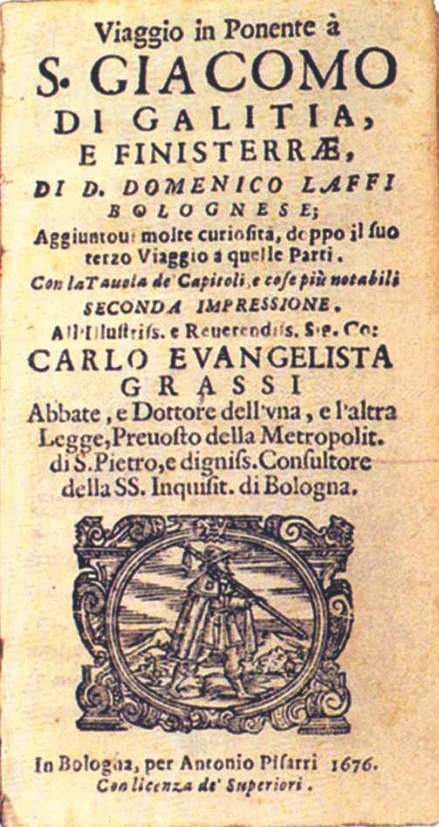
Pilgrims did not start to come this far west till the 1980s, when a growing number of people, especially foreigners, began to arrive here, attracted by the excitement of encountering the Atlantic finis terrae, the end of Europe, and seeing the immense ocean. Some were also attracted by religious sentiment towards the Holy Christ of Fisterra or the Virgin of A Barca.
Associations of Friends of the Way of St James had to a lot to do with the recovery of this route. One of the most active in this regard was the Galician association, especially when it was led by the chairman and local historian Antón Pombo, who was deeply involved in the project to recover the prolongation of the Way.
From 1993 onwards, the route began to be included in publications that promoted the Way of St James, and the first books and leaflets specifically about this route began to be published, with descriptions of the stages along the way, the places it passes through and the most important elements of the architectural and cultural heritage to be discovered there.
Pilgrimages organised by Asociación Nería in 1997, 1998 and 1999 attracted a large number of pilgrims from different parts of Spain and helped to promote this part of the Way of St James.
Once the route was indicated and recognised by the public administrations, the next step was to build the first pilgrims’ hostels, which are an essential part of the infrastructure for consolidating the route and increasing the number of pilgrims. The first to be opened was the hostel of Fisterra in 2001, followed by Negreira, Olveiroa, Corcubión, Muxía and Dumbría along with many private hostels.
Since then, the number of pilgrims has steadily grown, despite the obstacles placed by the religious authorities in Santiago, who refused to recognise this part of the Way, alleging that it was not a religious route, when, as mentioned above, both Fisterra and Muxía were already included in the legend of the arrival of the body of St James in Galicia, which is the main reason behind the pilgrimage to Compostela. Another factor is the importance of the chapels of O Cristo de Fisterra and the Virxe da Barca to the Church.
This route is now one of the most popular amongst pilgrims who take the French Way to Compostela. About 30% of the pilgrims who arrive in Santiago state that they intend to continue onwards to Fisterra and Muxía.
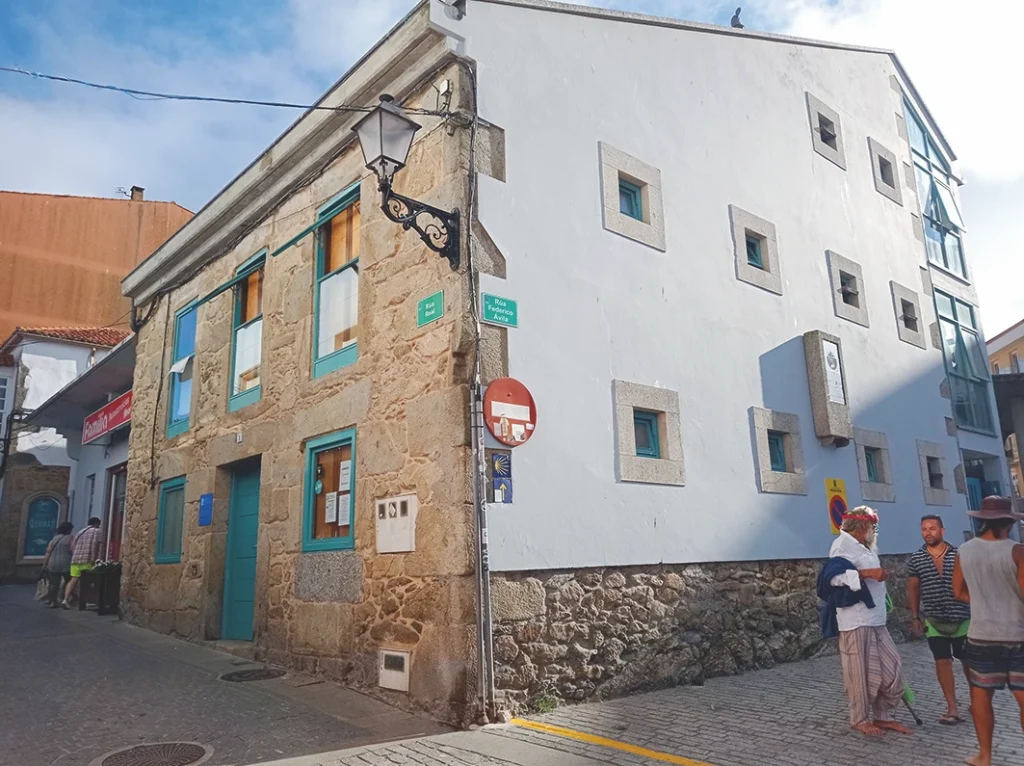
> Stages of the Way of Saint James of Fisterra and Muxía
This part of the Way of St James from Santiago to Fisterra and Muxía, which takes pilgrims to the edge of Europe and the shores of the Atlantic Ocean, has two points of arrival: Fisterra and Muxía. The route is divided into three stages, with another one that connects the two towns.
The first two: Santiago-Negreira and Negreira- Olveiroa are shared stages to reach either destination. The third one splits at the top of O Hospital de Logoso. The trail to the right takes you to Muxia after passing through Dumbría, while the one on the left passes through Cee and Corcubión and then ends at Fisterra.
Then there is a fourth stage that connects the two points of arrival: Fisterra and Muxia, which is a trail that runs along the coast between the two towns.
Stage one: Santiago- Negreira (21 km).
This first stage starts at the Praza do Obradoiro in Santiago. Head westwards along the streets of As Hortas and Poza de Bar to leave the city. Pass through the oak grove of San Lourenzo (old monastery) and cross the Sarela bridge. You’ll pass through some small villages and hamlets in the region of A Maía up to O Alto do Vento, and then head down through Ventosa and Lombao until you come to Augapesada, where there is a small medieval bridge. Now the trail heads upwards along the coast of O Mar de Ovellas, where there are some beautiful views of A Maía. After leaving this region you enter A Barcala and pass through Santa María de Trasmonte, with the impressive Baroque tower of the parish church. Then head down through Reino and Burgueiros and come to A Ponte Maceira, where you cross medieval bridge over the river Tambre. The bridge and the well-conserved centre of the village are well worth visiting. Continue along the right bank of the river till you pass under an arch of the Ponte Nova (19th c.), go through the hamlets of Barca and Chancela, and after passing near the manor house of Chancela, you arrive at the town of Negreira, capital of A Barcala.
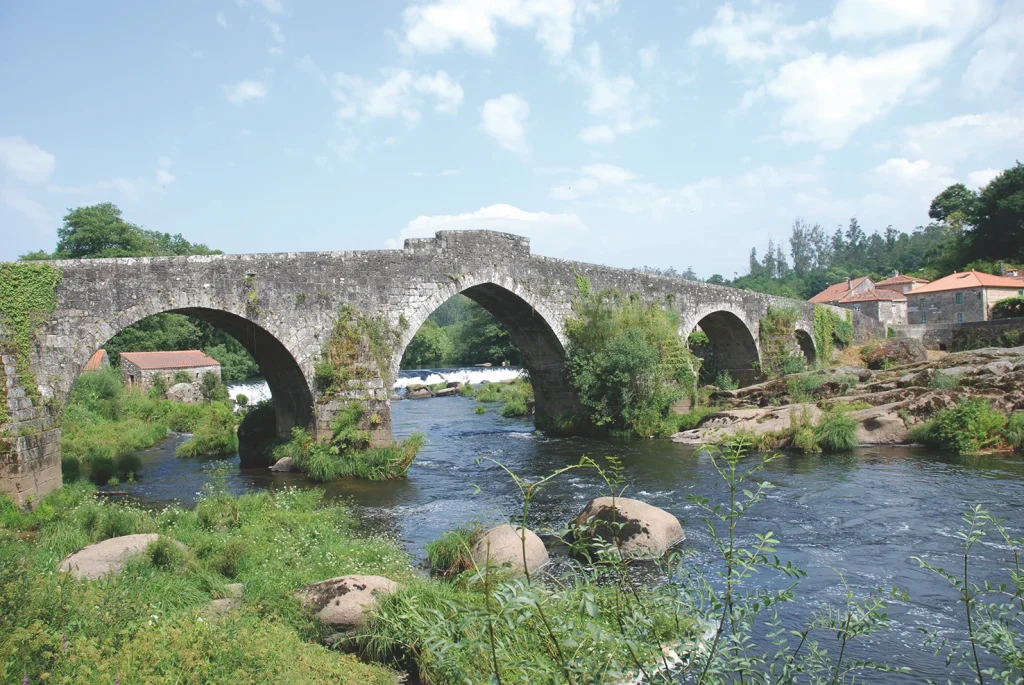
Stage two: Negreira- Olveiroa (33 km).
This is one of the longest stages of this route. Leave Negreira and after crossing the river Barcala, head up towards Zas and then take the old royal road that heads up the slope of the valley. The route passes through the hamlets of Camiño Real, Rapote, Piaxe, with the Baroque church of San Mamede de A Pena, and Portocamiño, and then goes down toward Vilaserío. There is a small municipal hostel here. Carry on towards Cornado and once you leave the hamlet, you enter the flatlands of the region of O Xallas. Further ahead are the hamlets of Maroñas and Santa Mariña, the latter of which has a Romanesque church. After crossing the road between Santa Comba and Muros, the trail continues westward, passing through the small hamlets of Bon Xesús, Gueima and Vilar de Castro. After leaving Vilar de Castro, you start the ascent of Monte Aro (556 m), which towers over the entire plateau and offers a magnificent view over the reservoir of A Fervenza. Then pass through Abelairoas and San Cristovo de Corzón on you way down to the river Xallas. Cross the bridge of A Ponte Olveira, parts of which date back to the 16th c., and then you enter the municipality of Dumbría, before finally reaching Olveiroa and the end of this second stage.
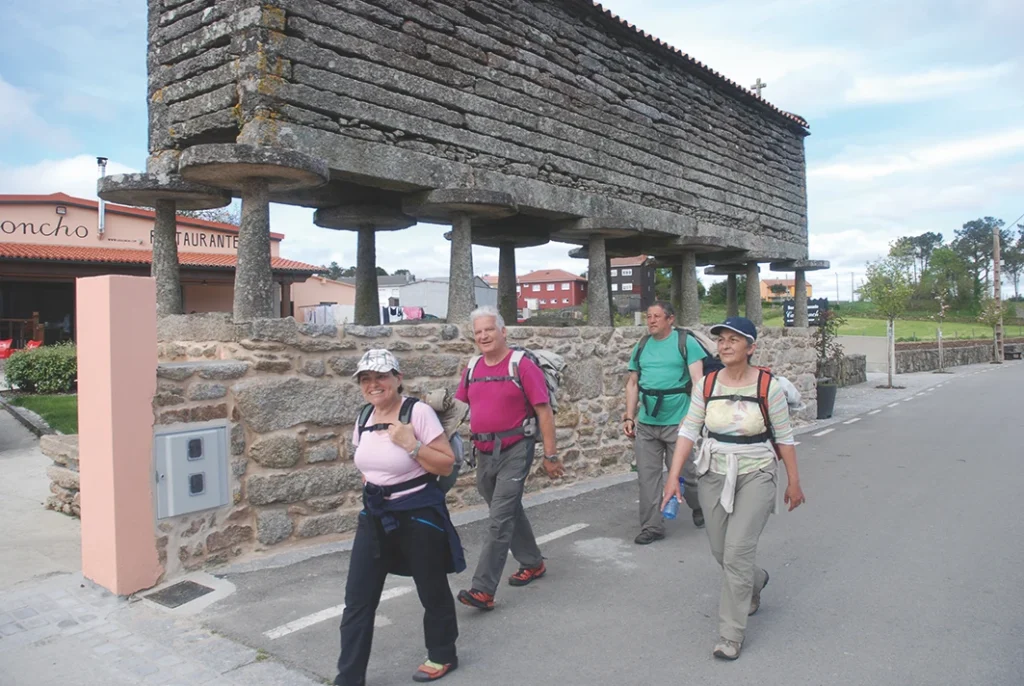
Stage three: Olveiroa- Fisterra (34 km) or Olveiroa-Muxía (32 km).
Shortly after leaving Olveiroa, the path follows a stream as it heads upwards on the slope of Monte Sino. It then passes through the hamlet of Logoso, before arriving at Hospital, whose name refers to a pilgrims’ hospital that was once here. Further on you come to a roundabout on the main road, where the trial divides into two. If you take the route to the left, you arrive at Fisterra, if you go straight on, the trail takes you to Muxía.

The path to Fisterra passes near the calvary of O Couto, the chapel of Nuestra Señora de As Neves and San Pedro Mártir, and then goes down Monte de A Armada towards the ría of Corcubión. Pass through Cee and then enter the historical town of Corcubión. From there go up to the top of San Roque, where there is a hostel. Go through Amarela to the beach of Estorde, and then carry on through Sardiñeiro and the small bay of Talón. Then you come to the long beach of A Langosteira, which takes you to the calvary of A Cruz de Baixar, the entrance to the town of Fisterra and the end of this part of the route. Places to see in this town are cape Fisterra and the parish church of Santa María das Areas, which is home to the chapel of the Santo Cristo.
The way to Muxía goes along a hilly section and then heads down to the hamlet of As Carizas. Pass through the sports and leisure area of O Conco, where there is a pilgrims’ hostel. Then head towards Santa Eulalia de Dumbría, the capital of the municipality, where you can see the 17th c. parish church. Carry on to the bridge of O Val de Liñares, and after crossing the 552 regional road, keep going to Trasufre, which is famous for being the sanctuary of the Virxe do Espiño. Cross the river Castro, and a set of tracks through the fields take you to Senande. Pass through A Grixa, where you can see the church of San Cibrán de Vilastose. A track through a wooded hill takes you to Quintáns, and from there you head along the old dirt track that has now been converted into a path to San Martiño de Ozón, where there used to be a monastery, and where there is a site of great architectural interest made up of the church, the rector’s house and a large hórreo. The path continues through Vilar de Sobremonte and Merexo on its way to Os Muíños. Then it heads up to Moraime, which was and important historical centre.
Here there are Roman and Visigothic ruins and a beautiful Romanesque church and Baroque rector’s house. From here head up to the top of Chorente, where you can visit the chapel of San Roque. After passing through the hamlet of Chorente, go down to the beaches of O Espiñeirido and A Cruz and enter the town of Muxía, which you pass through on your way to the chapel of the Virxe da Barca and the famous stones of Abalar and Os Cadrís, where this stage ends.
Stage four: Fisterra- Muxía (29 km).
This fourth stage goes both ways, so you can start in Fisterra or Muxía.
If you start in Fisterra, leave the town and take the path to the parish of San Martiño de Duio: here you can see the valley where the mythical city of Dugium mentioned in the Codex Calixtinus is supposed to be.
Pass through Hermedesuxo de Abaixo, San Salvador, Rial and Castrexe, and head onto Padrís, with the long beach of O Rostro to your left.
Then continue through Canosa to Lires, which is a tourist village located in the middle of this stage. From here head down to the river Castro, which you cross via a stone footbridge built only a few years ago. Enter the municipality of Muxía via Vaosilveiro and continue through Frixe, which still has its Romanesque church. Then pass through Guisamonde and Morquintián, and from there on the trail heads up towards Vilela and the top of As Aferroas, before heading down to Xurarantes and the beach of Lourido.

Follow the shore of the beach until you come to Muxía. When you enter the town, take the path in the Praza do Coído that goes to the area of A Pel and takes you to the chapel of the Virxe da Barca and the famous stones of Abalar and Os Cadrís, where this stage ends.